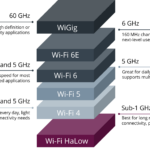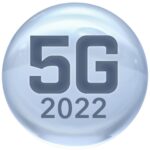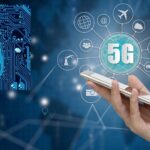Smooth transitions from 5G to Wi-Fi networks as you move seems obvious, but technology differences keep convergence from solidifying.
 Call it the holy grail of wireless communications: cellular/Wi-Fi convergence. It’s a vision of a future where cellular and Wi-Fi come together within a unified, tightly integrated architecture. For consumers, roaming from Wi-Fi to cellular and back without ever changing a setting offers a simple, seamless wireless experience. For enterprises and industry looking to fill coverage caps and support mission-critical connectivity, the use cases get even more compelling.
Call it the holy grail of wireless communications: cellular/Wi-Fi convergence. It’s a vision of a future where cellular and Wi-Fi come together within a unified, tightly integrated architecture. For consumers, roaming from Wi-Fi to cellular and back without ever changing a setting offers a simple, seamless wireless experience. For enterprises and industry looking to fill coverage caps and support mission-critical connectivity, the use cases get even more compelling.
Although the industry has talked about cellular/Wi-Fi convergence for years, we’ve never quite achieved it, at least not at scale. As both cellular and Wi-Fi technologies evolve ever-more advanced capabilities, it’s fair to ask why. Will these two worlds of wireless ever come together? And how close are we to seeing it happen? Let’s take a closer look.
Coexistence vs. convergence
We might not have true convergence yet, but we’ve had coexistence for a while, where cellular and Wi-Fi remain separate but exist side-by-side. Three main flavors of coexistence are becoming more common:
- Physical layer coexistence: In this model, service providers extend cellular services to share unlicensed spectrum with Wi-Fi. This is an attractive option for things like filling in dead spots in cellular coverage or offloading local traffic to Wi-Fi, instead of backhauling it through m
Cellular routers bring internet access to remote locations through Wi-Fi and Ethernet networks. Image: Sierra Wireless
ore expensive core and transport infrastructure.
- Best connection coexistence: Here, devices evaluate whether Wi-Fi or cellular offers better-quality service, and auto-join that network. iPhones already ship with this capability. And we use a manual version all the time, such as when you switch your phone to cellular when your home Wi-Fi has issues.
- Cellular/Wi-Fi hotspot coexistence: Here, a cellular-connected device creates a local Wi-Fi network for other devices. Most smartphones now offer “personal hotspot” features. Operators are also looking to use it for residential broadband, giving subscribers 5G-connected Wi-Fi routers for their primary home Internet.
Driving convergence demand
You can accomplish a lot with coexistence, but many in the industry continue to push for a deeper level of convergence. Today, the market is zeroing in on four main areas:
 Enterprise and campus networks: Enterprises want more seamless handovers between cellular and Wi-Fi. For example, they’d like an employee on a Zoom call to be able to move transparently from car to parking garage to office (roaming indoors, outdoors, and everywhere in between) with uninterrupted continuity.
Enterprise and campus networks: Enterprises want more seamless handovers between cellular and Wi-Fi. For example, they’d like an employee on a Zoom call to be able to move transparently from car to parking garage to office (roaming indoors, outdoors, and everywhere in between) with uninterrupted continuity. Industrial networks: Seamless cellular and Wi-Fi convergence is among the big drivers for private 5G networks now starting to roll out in factories. Here, the ability to automatically authenticate both SIM-enabled and Wi-Fi devices onto the network in a secure and transparent way is compelling. Industrial companies also want simultaneous cellular/Wi-Fi connectivity to improve resilience. For example, robots and autonomous vehicles in smart factories could have a fallback network to ensure they’re always connected and safely under control, even in areas with dead spots.
Industrial networks: Seamless cellular and Wi-Fi convergence is among the big drivers for private 5G networks now starting to roll out in factories. Here, the ability to automatically authenticate both SIM-enabled and Wi-Fi devices onto the network in a secure and transparent way is compelling. Industrial companies also want simultaneous cellular/Wi-Fi connectivity to improve resilience. For example, robots and autonomous vehicles in smart factories could have a fallback network to ensure they’re always connected and safely under control, even in areas with dead spots. Public hotspots: Operators are rolling out this convergence model in hotspots in dense city environments. Here, a hotspot or network of hotspots uses cellular credentials to authenticate and connect a subscriber to public Wi-Fi. Early solutions such as Passpoint do this today, and this type of convergence is getting more popular.
Public hotspots: Operators are rolling out this convergence model in hotspots in dense city environments. Here, a hotspot or network of hotspots uses cellular credentials to authenticate and connect a subscriber to public Wi-Fi. Early solutions such as Passpoint do this today, and this type of convergence is getting more popular. Home networks: A key theme across multiple use cases, deep convergence can enable seamless authentication and secure access. Today, businesses are looking to this model to support the growing number of work-from-home (WFH) employees. Workers can authenticate via cellular SIM to get access to the network, or even specific zones of the network, then use Wi-Fi for their primary connectivity.
Home networks: A key theme across multiple use cases, deep convergence can enable seamless authentication and secure access. Today, businesses are looking to this model to support the growing number of work-from-home (WFH) employees. Workers can authenticate via cellular SIM to get access to the network, or even specific zones of the network, then use Wi-Fi for their primary connectivity.
Industry groups have already taken steps to advance convergence for these and other use cases. In Release 15 of the 5G specification, for example, 3GPP defines mechanisms to allow Wi-Fi-based access networks to integrate onto the 5G network in both a trusted (via SIM authentication) or untrusted format. Release 16 will offer further enhancements to control connectivity in converged networks. Using Access Traffic Steering, Switching, and Splitting (ATSSS) technology, systems will be able to steer traffic from one network to the other, seamlessly hand off connections, and maintain simultaneous 5G/Wi-Fi connectivity for resiliency.
Clearing convergence hurdles
With both demand and standards work maturing, it’s only a matter of time before we see deep cellular/Wi-Fi convergence popping up everywhere, right? Well, let’s pump the brakes. Several outstanding questions still need to be answered in areas such as:
- Business value: Cellular and Wi-Fi technologies have long evolved in their own separate worlds, and some industry stakeholders believe there’s nothing wrong with that. Going beyond coexistence to build deep architectural convergence requires significant investment and industry cooperation, and some remain skeptical the end results will justify that effort.
- Adoption: Many of the technical capabilities to enable deep convergence come with Release 16 of the 5G specification, which devices don’t yet support and operators are only now starting to implement. Even when Release 16 is fully implemented, the convergence features are optional, so there’s no guarantee that service providers or device manufacturers will support them.
- Technology: Architectural convergence is just the first step. Significant work remains to address things like end-to-end quality of service and security. Both 5G and Wi-Fi use their own distinct policy frameworks, which would need to be coordinated—and that integration has not yet been in any way defined.
- Politics: Even assuming the industry works through these issues, it’s an open question whether Wi-Fi and cellular stakeholders will come together to really push mass-scale convergence. Many in each camp strongly believe that their technology can solve all wireless challenges. Even within service provider organizations and device manufacturers, you can find partisans on this issue.
Looking Ahead
We may yet see 5G/Wi-Fi convergence come to pass. Certainly, a growing list of use cases is drawing interest from users. Service providers, who want to expand their footprint with enterprises and extend SIM-based authentication to new use cases, have great reasons to advocate for it. For now, it remains to be seen whether we’ll ultimately see deep cellular/Wi-Fi convergence at scale. No matter what, this will be a fascinating area to watch.
 Stephen Douglas is head of market strategy at Spirent Communications. Follow him at @s_n_douglas.
Stephen Douglas is head of market strategy at Spirent Communications. Follow him at @s_n_douglas.







